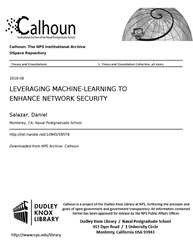File:LEVERAGING MACHINE-LEARNING TO ENHANCE NETWORK SECURITY (IA leveragingmachin1094559578).pdf

Original file (1,275 × 1,650 pixels, file size: 857 KB, MIME type: application/pdf, 82 pages)
Captions
Captions
Summary[edit]
| LEVERAGING MACHINE-LEARNING TO ENHANCE NETWORK SECURITY
( |
||
|---|---|---|
| Author |
Salazar, Daniel |
|
| Title |
LEVERAGING MACHINE-LEARNING TO ENHANCE NETWORK SECURITY |
|
| Publisher |
Monterey, CA; Naval Postgraduate School |
|
| Description |
This research examines the use of machine-learning techniques to identify malicious traffic in an emulated tactical computer network. The intent is to identify low-cost solutions based on open-source software capable of employment on computer hardware of currently fielded tactical data networks. These machine-learning techniques are investigated for application where it is prohibitive to employ bulky alternate network security measures such as security information and event management products. These methods are evaluated as a complementary solution to existing security measures, rather than as a replacement. A test network is established with sixteen hosts emulating generation of normal baseline traffic for periods of 48 hours. One machine is infected with a botnet simulator and sends malicious traffic at four levels of intensity. The traffic flows are captured, labeled, and used as training and testing sets for four commonly used machine-learning algorithms to generate models for identifying the botnet traffic. The trained models are then tested against other flow datasets to evaluate their ability to classify malicious traffic without prior signatures. We identify the J48 Decision Tree as the strongest single algorithm across six of our seven metrics. Our work also produces a report for network administrators that is clear, easy to understand, and most importantly, provides actionable information that can drive decisions to best defend the network. Subjects: machine-learning; botnets; network security |
|
| Language | English | |
| Publication date | June 2018 | |
| Current location |
IA Collections: navalpostgraduateschoollibrary; fedlink |
|
| Accession number |
leveragingmachin1094559578 |
|
| Source | ||
| Permission (Reusing this file) |
This publication is a work of the U.S. Government as defined in Title 17, United States Code, Section 101. Copyright protection is not available for this work in the United States. | |
Licensing[edit]
| Public domainPublic domainfalsefalse |
This work is in the public domain in the United States because it is a work prepared by an officer or employee of the United States Government as part of that person’s official duties under the terms of Title 17, Chapter 1, Section 105 of the US Code.
Note: This only applies to original works of the Federal Government and not to the work of any individual U.S. state, territory, commonwealth, county, municipality, or any other subdivision. This template also does not apply to postage stamp designs published by the United States Postal Service since 1978. (See § 313.6(C)(1) of Compendium of U.S. Copyright Office Practices). It also does not apply to certain US coins; see The US Mint Terms of Use.
|
 | |
| This file has been identified as being free of known restrictions under copyright law, including all related and neighboring rights. | ||
https://creativecommons.org/publicdomain/mark/1.0/PDMCreative Commons Public Domain Mark 1.0falsefalse
File history
Click on a date/time to view the file as it appeared at that time.
| Date/Time | Thumbnail | Dimensions | User | Comment | |
|---|---|---|---|---|---|
| current | 15:09, 22 July 2020 |  | 1,275 × 1,650, 82 pages (857 KB) | Fæ (talk | contribs) | FEDLINK - United States Federal Collection leveragingmachin1094559578 (User talk:Fæ/IA books#Fork8) (batch 1993-2020 #20759) |
You cannot overwrite this file.
File usage on Commons
The following page uses this file:
Metadata
This file contains additional information such as Exif metadata which may have been added by the digital camera, scanner, or software program used to create or digitize it. If the file has been modified from its original state, some details such as the timestamp may not fully reflect those of the original file. The timestamp is only as accurate as the clock in the camera, and it may be completely wrong.
| Short title | LEVERAGING MACHINE-LEARNING TO ENHANCE NETWORK SECURITY |
|---|---|
| Image title | |
| Author | Salazar, Daniel |
| Software used | Salazar, Daniel |
| Conversion program | Adobe PDF Library 11.0 |
| Encrypted | no |
| Page size |
|
| Version of PDF format | 1.4 |

